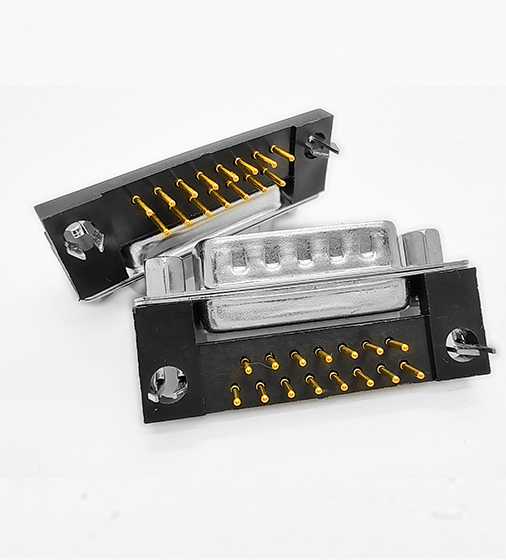D-Sub Connector Pin Count Size Range
2025-06-23
D-Sub connectors, widely used in various industries, are essential components for transferring electrical signals between devices. These connectors are characterized by their D-shaped metal shell, which provides durability and shielding from electromagnetic interference. Their primary use spans across applications such as computer interfaces, industrial machinery, telecommunications, and consumer electronics. One of the most critical features of D-Sub connectors is their pin count and corresponding size range, which are crucial for ensuring compatibility with specific systems and applications.
Pin Count of D-Sub Connectors
The pin count of D-Sub connectors varies widely, with options available for different configurations. The most common pin counts are 9, 15, 25, 37, and 50 pins, although there are many other configurations as well. These pin counts are typically denoted as DB9, DB15, DB25, DB37, and DB50, with the "DB" indicating the D-sub shape of the connector and the number following it representing the total number of pins.
DB9: A 9-pin D-Sub connector is one of the most common types, often used in legacy serial communications (RS-232) and some VGA video connections. Due to its compact size, it’s frequently found in older computer peripherals like mice, keyboards, and serial ports.
DB15: The 15-pin D-Sub connector is often used for VGA video output on older computers and monitors. It’s also found in audio, video, and industrial applications, offering a larger pin count to accommodate more complex signal transmission.
DB25: The 25-pin version is frequently used in parallel data transmission (e.g., printer connections in older systems) and serial communication applications. It is larger than the DB9 and DB15, offering more signal paths for increased functionality.
DB37 and DB50: These connectors, with 37 and 50 pins, are less common but still play an essential role in industrial control systems, data acquisition, and telecommunications equipment, where higher pin counts are needed to handle more complex connections.
In addition to these standard configurations, custom D-Sub connectors with varying pin counts may also be designed to meet specific needs in unique applications.
Size Range of D-Sub Connectors
The size of a D-Sub connector depends on both its pin count and the specific application for which it is designed. In general, the size of D-Sub connectors increases as the number of pins increases, but other factors like the connector’s construction and shielding can also influence its dimensions.
Small-Scale D-Sub Connectors: Connectors like the DB9 are relatively compact, with a height of about 12.3mm (0.48 inches) and a width of approximately 28mm (1.1 inches). These connectors are often used in systems where space is limited but a reliable, low-pin count connection is necessary.

Mid-Scale D-Sub Connectors: The DB15 and DB25 connectors are larger in size due to their increased number of pins. A DB15 typically has dimensions of about 19mm (0.75 inches) in height and 32mm (1.26 inches) in width, while the DB25 connector can be around 20mm (0.79 inches) in height and 49mm (1.93 inches) in width. These connectors are often used for applications requiring a moderate number of pins, such as video, audio, and data transmission.
Large-Scale D-Sub Connectors: The DB37 and DB50 are designed for applications with a high demand for multiple signal pathways. These connectors can be significantly larger, with the DB37 measuring around 21mm (0.83 inches) in height and 63mm (2.48 inches) in width, while the DB50 can measure about 23mm (0.91 inches) in height and 68mm (2.68 inches) in width.
While the size differences are notable, D-Sub connectors are often designed with robust mechanical features to ensure secure and reliable connections, even in larger forms. This includes features like screw locks or latches to prevent accidental disconnections.
Application of Different Pin Count Sizes
The appropriate pin count and size of a D-Sub connector are largely determined by the application requirements:
Low-Pin Count Applications: D-Sub connectors with lower pin counts, such as the DB9 and DB15, are suitable for simple, low-bandwidth applications. For example, DB9 connectors are commonly found in serial port connections, while DB15 connectors are used for VGA displays or audio signals.
High-Pin Count Applications: As the pin count increases, so does the capacity for transmitting more complex signals. D-Sub connectors like the DB25, DB37, and DB50 are used in applications such as industrial machinery, communication systems, and scientific equipment, where multiple signals need to be transmitted simultaneously.
Custom Applications: In cases where the standard pin configurations don’t meet the specific needs of a project, custom D-Sub connectors can be created with pin counts tailored to the exact requirements. This is common in specialized industrial and aerospace applications.
Conclusion
The pin count and size range of D-Sub connectors are fundamental considerations in their design and selection for various applications. Whether for low-speed serial communication or high-speed industrial data transmission, the pin count determines the amount of data that can be transferred, while the size ensures compatibility with the devices and systems being connected. The flexibility in pin counts and sizes ensures that D-Sub connectors remain a versatile and essential choice in numerous fields, from consumer electronics to industrial automation.
As a professional manufacturer and supplier, we provide high-quality products. If you are interested in our products or have any questions, please feel free to contact us.